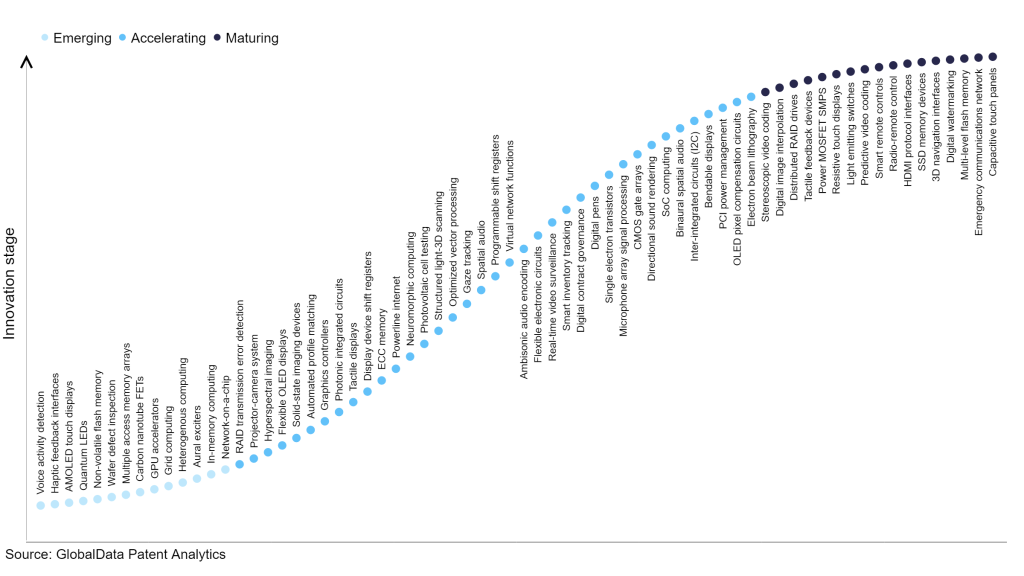The technology industry continues to be a hotbed of patent innovation. Activity is driven by the demand for high-resolution imaging in applications like smartphones, digital cameras, and medical devices, and growing importance of technologies such as complementary metal-oxide-semiconductor (CMOS) and charge-coupled device (CCD) sensors, both of which play vital roles in converting light into electrical signals for image capture and processing. In the last three years alone, there have been over 4.1 million patents filed and granted in the technology industry, according to GlobalData’s report on Innovation in technology: solid-state imaging devices. Buy the report here.
However, not all innovations are equal and nor do they follow a constant upward trend. Instead, their evolution takes the form of an S-shaped curve that reflects their typical lifecycle from early emergence to accelerating adoption, before finally stabilizing and reaching maturity.
Identifying where a particular innovation is on this journey, especially those that are in the emerging and accelerating stages, is essential for understanding their current level of adoption and the likely future trajectory and impact they will have.
190+ innovations will shape the technology industry
According to GlobalData’s Technology Foresights, which plots the S-curve for the technology industry using innovation intensity models built on over 1.5 million patents, there are 190+ innovation areas that will shape the future of the industry.
Within the emerging innovation stage, network-on-a-chip, in-memory computing, and aural exciters are disruptive technologies that are in the early stages of application and should be tracked closely. Electron beam lithography, OLED pixel compensation circuits, and PCI power management are some of the accelerating innovation areas, where adoption has been steadily increasing. Among maturing innovation areas are capacitive touch panels and emergency communications network, which are now well established in the industry.
Innovation S-curve for the technology industry

Solid-state imaging devices is a key innovation area in technology
Solid-state imaging devices utilize semiconductors to transform light into electrical signals, finding widespread use in digital cameras, medical imaging, and various applications necessitating high-quality visual capture.
GlobalData’s analysis also uncovers the companies at the forefront of each innovation area and assesses the potential reach and impact of their patenting activity across different applications and geographies. According to GlobalData, there are 60+ companies, spanning technology vendors, established technology companies, and up-and-coming start-ups engaged in the development and application of solid-state imaging devices.
Key players in solid-state imaging devices – a disruptive innovation in the technology industry
‘Application diversity’ measures the number of applications identified for each patent. It broadly splits companies into either ‘niche’ or ‘diversified’ innovators.
‘Geographic reach’ refers to the number of countries each patent is registered in. It reflects the breadth of geographic application intended, ranging from ‘global’ to ‘local’.
Patent volumes related to solid-state imaging devices
| Company | Total patents (2010 - 2022) | Premium intelligence on the world's largest companies |
| Fujifilm | 14 | Unlock Company Profile |
| Qualcomm | 20 | Unlock Company Profile |
| PixArt Imaging | 10 | Unlock Company Profile |
| AUO | 4 | Unlock Company Profile |
| BYD | 5 | Unlock Company Profile |
| Taiwan Semiconductor Manufacturing | 16 | Unlock Company Profile |
| CEA | 7 | Unlock Company Profile |
| Cellect | 5 | Unlock Company Profile |
| Ricoh | 9 | Unlock Company Profile |
| Olympus | 14 | Unlock Company Profile |
| Renesas Electronics | 11 | Unlock Company Profile |
| Canon | 197 | Unlock Company Profile |
| Sony Group | 461 | Unlock Company Profile |
| Innolux | 7 | Unlock Company Profile |
| Toshiba | 11 | Unlock Company Profile |
| Nikon | 58 | Unlock Company Profile |
| Hamamatsu Photonics KK | 12 | Unlock Company Profile |
| Semiconductor Energy Laboratory | 30 | Unlock Company Profile |
| Guangdong Oppo Mobile Telecommunications | 4 | Unlock Company Profile |
| Japan Broadcasting | 8 | Unlock Company Profile |
| Pixart Imaging (Penang) Sdn. Bhd. | 4 | Unlock Company Profile |
| Shenzhen Goodix Technology | 5 | Unlock Company Profile |
| SmartSens Technology | 13 | Unlock Company Profile |
| Beijing SuperPix Micro Technology | 12 | Unlock Company Profile |
| Prophesee | 6 | Unlock Company Profile |
| New Imaging Technologies | 4 | Unlock Company Profile |
| Shanghai Ic R&D Center | 11 | Unlock Company Profile |
| Shanghai Integrated Circuit Research & Development Center | 6 | Unlock Company Profile |
| Lynred | 4 | Unlock Company Profile |
| Ace Kai Hynix | 9 | Unlock Company Profile |
| Shanghai Integrated Circuit Research and Development Center | 6 | Unlock Company Profile |
| Chengdu Weiguang Jidian Technology | 5 | Unlock Company Profile |
Source: GlobalData Patent Analytics
Among the companies innovating in solid-state imaging devices, Sony Group is one of the leading patents filers. The company’s patent describes technique pertaining to a solid-state imaging device, its manufacturing process, and an electronic device. It aims to produce a compact, highly integrated imaging device that prevents the occurrence of RTS noise caused by the downsizing of amplifying transistors. This is achieved, in part, by incorporating a fully depleted type amplifying transistor, which features an amplifier gate extending perpendicularly to the processed surface layer of a semiconductor. ther prominent patent filers in the space include Canon and Nikon.
In terms of application diversity, Cellect leads the pack, while Semiconductor Energy Laboratory and Taiwan Semiconductor Manufacturing stood in second and third positions, respectively. By means of geographic reach, Qualcomm held the top position, followed by Prophesee and Cellect.
Solid-state imaging devices play a pivotal role in modern technology by converting light into electrical signals, enabling the capture of high-quality images in various applications. Their compact size, high integration, and reliability make them indispensable in fields such as digital photography, medical imaging, security systems, and many other areas.
To further understand the key themes and technologies disrupting the technology industry, access GlobalData’s latest thematic research report on Technology.
Premium Insights
From

The gold standard of business intelligence.
Blending expert knowledge with cutting-edge technology, GlobalData’s unrivalled proprietary data will enable you to decode what’s happening in your market. You can make better informed decisions and gain a future-proof advantage over your competitors.



